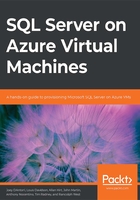
1. Introduction to SQL Server on Azure Virtual Machines
Introduction
In this chapter, we introduce the relational SQL Server products that you can use in Azure to store and process transactional data in a relational format, which is to say data stored in tables and columns. To get started on this discussion, there are a few terms and concepts that are important to understand.
The concepts of platform as a service (PaaS) and infrastructure as a service (IaaS) can be confusing and are used constantly when discussing services that allow you to build software on a cloud service. The fundamental distinction between the two lies in how managed the offering is. A service being managed means that the provider handles some amount of the operation (or management) of the service. When you install an operating system and SQL Server on your on-premises computer, you manage the entire hardware and software infrastructure yourself. This starts with making sure the server is plugged in and everything else moves from there. PaaS and IaaS both indicate managed services because the resources you use will be managed to some extent.
PaaS indicates that you are getting a platform to work with, and more of the management tasks such as software patching, performance tuning, backups, and fault tolerance will be handled by Azure. The goal is to let you focus on providing business value and leave the day-to-day operations to Microsoft. How much of the management is done for you is based on the features of the offering, but as an example, each of the PaaS offerings we will introduce will handle backups of your data without you or your customer thinking too much about it, until you find the need to restore your data.
The IaaS model primarily provides management of the hardware and network. You never need to, and never can, touch any of the physical resources or even access the location of the server. Just like when you get a new computer, an IaaS server may have software pre-installed for you, but once you take over the computer, managing and configuring the software and hardware is up to you. The Azure IaaS platform for SQL Server does include tools to help you automate the management of the software, giving you some of the characteristics of the PaaS model, but these tools will not be as controlled in the IaaS model as they will in a PaaS-model server.
A managed database service does not indicate that the Azure platform will change the meaning of any data or code you have written; in fact, it's quite the opposite. This is still part of what your organization needs to do. No changes will be made to your system that change the meaning of the structures you create. You will simply need to be less concerned with day-to-day processes that are common to pretty much every organization.
This book largely focuses on the IaaS offering using SQL Server on Azure Virtual Machines, though we will introduce the PaaS offerings for contrast. The rest of this chapter will introduce the Azure SQL offerings, the newest features in SQL Server 2019, and the value of using SQL Server in its IaaS configuration.